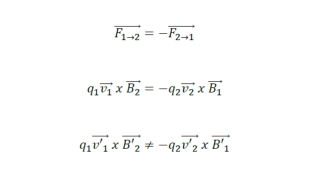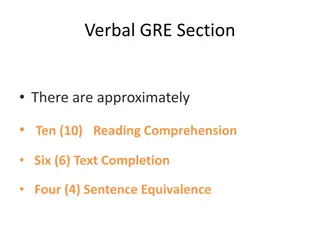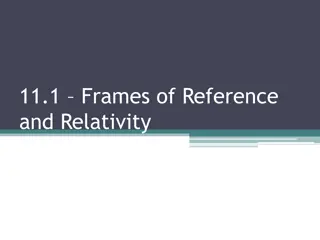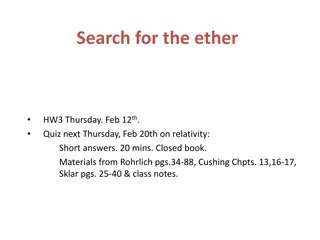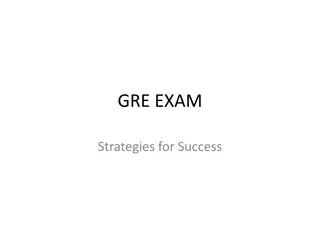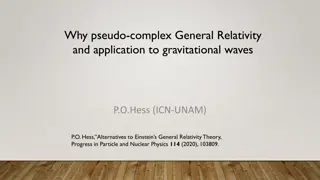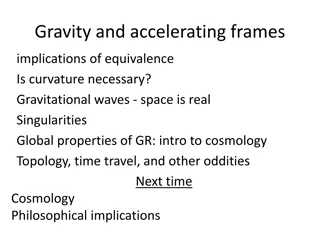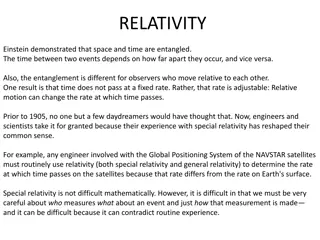Understanding Relativity for the GRE Examination
Explore the essential concepts of relativity, mathematics, statistics, and lab methods crucial for the GRE. Delve into special relativity, reference frames, velocity addition, Lorentz transformations, and relativistic collisions. Gain insights into key relationships, relativistic mass, momentum, kinetic energy, time dilation, and length contraction. Understand Lorentz transformations and relativistic collisions through detailed examples and problems.
Download Presentation

Please find below an Image/Link to download the presentation.
The content on the website is provided AS IS for your information and personal use only. It may not be sold, licensed, or shared on other websites without obtaining consent from the author. Download presentation by click this link. If you encounter any issues during the download, it is possible that the publisher has removed the file from their server.
E N D
Presentation Transcript
Relativity, Mathematics, Statistics, & Lab Methods to know for the GRE
Special Relativity Main Concepts and Equations
Main Concepts Reference Frames Velocity Addition Lorentz Transformations Relativistic collisions Minkowski diagrams
Reference Frames Stationary Frame: Moving Frame: Experiences time normally At speeds approaching c stationary objects move through time more slowly Views objects approaching c as compressing Stationary objects appear to stretch and elongate Fast moving objects appear to experience time more slowly Within their reference frame moving objects experience time normally.
Velocity Addition Example Problem: A ship travelling at .8c launches a projectile at .6c relative to it, what is the speed of the projectile to a stationary observer? Classically: ? = ??+ ?? ??+?? ?+ Einstein Velocity addition: ? = ???? ??
Basic Relativistic Conversions Key relationships: At .5c: At 3/5c: At 4/5c: = 1.512 1 = = 1.155 = 1.25 1 ?2 ?2 Relativistic Mass ? = ?0 Relativistic Momentum p= ?0 ? Relativistic Kinetic Energy ??= ( 1)?0?2 Time Dilation ? = ? Length Contraction ? = ?
Lorentz Transformations Assuming a body moving with a velocity in the x direction: ? = (? +?? ? = (? ?? ?2) ?2) The Lorentz transformations are derived from the following equation which is always true ? = (? + ?? ) ?2?2 ?2 ?2 ?2= ? 2? 2 ? 2 ? 2 ? 2 ? = (? ??) Type equation here. ? = ? ? = ? ? = ? ? = ?
Relativistic Collisions Key Terms: Example Question: A particle of mass m is moving at 4/5c, collides inelastically with another particle of equal mass at rest. ?????= ?0?2 p= ?0 ? ??=? ? ????= ??+ ????? Find its composite mass and velocity. 4 3 4 5 ??=?? ? =5 ????/?= ?????+ ??=8 ?? 2=4 = 3? 3? ??= 3? ? 4 5 1 4 3? 8 3? ??=?? =? 4 ??2= ??2 ??2 = ??= 3? ?? 2
Minkowski Diagrams Two spaceships moving at .5 c are 3?108m apart at t=-1, the first one shines a light at a mirror on the back of the second. t t t 1 s x 1 s x x 3?108 -1s -1s
Dot & Cross Product Identities Dot Product ? ? = ? ? cos(?) Cross product ? ? = ? ? sin(?) ? ? = ????+????+???? Yields a scalar quantity Yields a vector
Matrices & Determinants Det? ? ? = ?? ?? ?
Gradient Theorem Interpretation: if you were to measure how high a building was by measuring one floor and counting the total floors and adding them, or by simply taking a measurement of the altitude at the top subtracted from that at the bottom, you expect to get the same answer.
Greens Divergence Theorem / Gauss Law The divergence measures how much the function spreads out over time ?????? ?????? ?????? ?????? = ???? ??? ?? ??????? (a) & (c) show positive divergence
Stokes Theorem of Curl (Flux) Curl over a region or surface is equal to the value of the function at the boundary Curl measures how much rotation there is in the medium Both images have nonzero curl
Laplacian- divergence of the gradient ?2? ?2?2+ ?2? ?2?2+ ?2? ?2?2 ?2? = ? ?? = ? ?? = 0 ? ? ? = 0 ? ? ? = ? ? ? ?2?
Coordinate Systems: Spherical Integration: ?? = ?2sin??? ?? ?? Cartesian to Spherical ? = ? = tan 1? ?2+ ?2+ ?2 ? ? ? = cos 1 ?2+?2+?2 Spherical to Cartesian ? = ?sin?cos? ? = ?sin?sin? ? = ?cos?
Coordinate Systems: Cylindrical Cartesian to Cylindrical ? = ? = tan 1? ?2+ ?2 Integration: ?? = ? ?? ?? ?? ? z=z Cylindrical to Cartesian ? = ?cos? ? = ?sin? z=z
Trig Identities ???= cos? + ?sin?
Fourier series Fourier series are the expansion of a periodic function into sin and cos terms. The sin and cos terms are orthogonal, so they do not contribute at the same terms.
Binomial distribution For situations with discrete binary outcomes (Y/N, probability p of Y) The probability of k successes over n trials is
Gaussian distribution A continuous normalized probability distribution about a mean, shaped like a bell. The normalization constant is in front.
Poisson distribution A discrete probability distribution of events happening at a known rate and independent probability of one another. (ex. radioactive decay) If is the expected number of events in a given time period, the probability of k events is, with mean and standard deviation ?.
Taylor series The approximation of a function f(x) at x = a is represented by Some common Taylor series:
Lab Methods Dimensional Analysis GRE asked for the slope of a plot in terms of fundamental constant, just look at dimensions of the ratio y/x. Log Plots: Never show zero on the axes, A straight line on log-log plot corresponds to y=axb, A straight line on a log-linear plot corresponds to an exponential growth law, y=C. 10bx
Statistics Estimate of spread: Sample Variance Uncertainty : uncertainty of 10% means s x=.1 Precise measurement: small variance Accurate measurement: Closer to the true value
Poisson Processes For large N How rare the process is, if is small, likely to observe no events
Electronics Capacitor Inductor Resistor Series Parallel
One Inductor and Capacitor Circuit The numerator vanishes when , the resonant frequency
Advance Circuit Elements Diode: Doesn t follow Ohm s law, current only flows one direction Op-amp: Two inputs one output, output proportional to the difference of input voltages
Logic Gates Or gate (A+B) And gate(A.B) True either A or B is true True if both A & B are true False when both A &B are false False otherwise The inputs can be inverted using a NOT gate
Inverting output of AND and OR gates give NAND and NOR gates All basic logic gates can be constructed from the combination of these two gates De Morgan s Laws in Boolean Algebra:
Interactions of Charged Particles with Matter Range: Nuclei are stopped faster than the electrons, energy loss/length is much higher for nuclei than for electrons Path Shape: Nuclei tend to travel is straight line Energy Loss: Nuclei lose energy exclusively due to collisions, rather than by emitting radiation.
Photon Interactions Photoabsorption(photoelectric): Photon completely absorbed by an atom, and an electron is emitted. Compton Scattering: Photon scatters off an atomic electron, the wider the scattering angle, the more energy it loses to the electron. Compton Wavelength
Lasers The process of photons from decaying excited states being absorbed by other excited states, called stimulated emission, starts a chain reaction, the product of which is an exponentially large number of photons, all with exactly the same frequency and phase, this is laser light.
Types of Lasers Solid-state lasers: (Nd-YAG) Collisional Gas Lasers: (He-Ne) Molecular Gas Lasers: (CO2)




